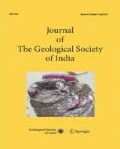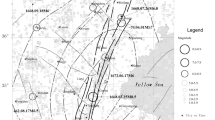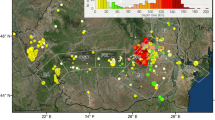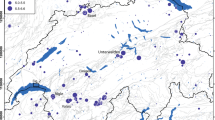Abstract
Given the lack of proper constraints in understanding earthquake mechanisms in the cratonic interiors and the general absence of good quality database, here we reassess the seismic hazard in the province of Kerala, a part of the •stable continental interior•, based on an improved historical and instrumental database. The temporal pattern of the current seismicity suggests that >60% of the microtremors in Kerala occurs with a time lag after the peak rainfall, indicating that hydroseismicity may be a plausible model to explain the low-level seismicity in this region. Further, an increment in overall seismicity rate in the region in the recent years is explained as due to increased anthropogenic activities, which includes changes in hydrological pathways as a consequence of rapid landscape changes. Our analyses of the historical database eliminate a few events that are ascribed to this region; this exercise has also led to identification of a few events, not previously noted. The improved historical database essentially suggests that the central midland region is more prone to seismic activity compared to other parts of Kerala. This region appears to have generated larger number of significant earthquakes; the most prominent being the multiple events (doublets) of 1856 and 1953, whose magnitudes are comparable to that of the 2000/2001 (central Kerala) events. Occurrences of these historical events and the recent earthquakes, and the local geology indicative of pervasive faulting as shown by widely distributed pseudotachylite veins suggest that the NNW-SSE trending faults in central midland Kerala may host discrete potentially active sources that may be capable of generating light to moderate size earthquakes. The frequency of earthquakes in central Kerala evident from the historical database requires that the seismic codes stipulated for this region are made mandatory.
Similar content being viewed by others
References
Ballore, M.D.E. (1900) Seismic phenomenon in British India and their connection with its geology. Mem. Geol. Surv. India, v.35, pt.3, pp.153–193.
Bhatia, S.C., Kumar, M.R. and Gupta, H.K. (1999) A Probabilistic Seismic Hazard Map of India and Adjoining Regions, http://www.seismo.ethz.ch/gshap/ict/india.html, pp.1–12.
Bhattacharya, S.N. and Dattatrayam, R.S. (2002) Earthquake sequences in Kerala during December 2000 and January 2001. Curr. Sci., v.82, pp.1275–1278.
Bendick, R. and Bilham, R. (1999) Search for buckling of the southeast Indian coast related to Himalayan collision. Geol. Soc. Amer., Spec. Paper 328, pp.313–321.
Brodsky, E.E., Roeloffs, E., Woodstock, D., Gall, I. and Manga, M. (2003) A mechanism for sustained groundwater pressure changes induced by distant earthquakes. Jour. Geophys. Res., B, 108B8, doi: 10.1029/2002JB) 2321
Bolt, B.A. (2003) “Earthquakes” Fifth edition. W.H. Freeman and Company, Basingstoke, England.
Brown, J.A. (1857) Accounts of an earthquake in Travancore, 11th August 1856. Trans. Bom. Geogr. Soc., v.13, Appendix C, pp.7–13.
Chandra, U. (1977) Earthquakes of peninsular India: A seismotectonic study Bull. Seism. Soc. Amer., v.67, pp.1387–1413.
Chandrasekharam, D. (1985) Structure and evolution of the western continental margin of India deduced from gravity, seismic, geomagnetic and geochronological studies, Phys. Earth Planet. Inter., v.41, pp.186–198.
Crone, A.J., Machette, M.N. and Bowman, J.R. (1992) Geologic investigations of the 1988 Tennant Creek, Australia, Earthquakes ...Implications for paleoseismicity in stable continental regions. U.S. Geol. Surv. Bull., v.2032-A, 51p.
Crone, A.J., Machette, M.N. and Bowman, J.R. (1997) Episodic nature of earthquake activity in stable continental region revealed by paleoseismicity studies of Australian and North American Quaternary faults. Aust. Jour. Earth. Sci., v.44, pp.203–214.
Crone, A.J., Martini, P.M., Machette, M.N., Okumura, K. and Prescott, J.R. (2003) Paleoseismicity of two historically quiescent faults in Australia: Implications for fault behavior in stable continental regions. Bull. Sesim. Soc. Amer., v.93, pp.1913–1934.
Costain, J.K, Bollinger, G.A. and Speer, J.A.S (1987) Hydroseismicity-a hypothesis for the role of water in generation of intraplate seismicity. Geology, v.15, pp.618–621.
Costain, J.K. and Bollinger, G.A. (1996) Climatic changes, streamflow, and long-term forecasting of intraplate seismicity. Jour. Geodynamics, v.22, pp.19–117.
Ghosh, J.G., de Wit, M.J. and Zartman, R.E. (2004) Age and tectonic evolution of Neoproterozoic ductile shear zones in the southern granulite terrain of India, with implication for Gondwana studies. Tectonics, 22, TC3006, doi, 10.1029/2002TC001444.
GSI (2000) Seismotectonic atlas of India and its environs. Geol. Surv. India, Kolkata, 209p.
GSI (1989) Quadrangle Geological map 58F&G.
GSI (1992) Quadrangle Geological map 58B.
GSI (1995) Quadrangle Geological map 58C.
Gubin, I.E. (1968) Seismic zoning map of western margin of Indian peninsula, Bull. Int. Inst. Seism. Earthquake Engineering, v.5, pp.109–139.
Gopal., V. (1953) A note on the investigations into the recent earthquake shocks in Kottayam District, Travancore-Cochin. Unpublished report, Geol. Surv. India, Kolkatta, 6p.
Gutenberg, B. and Richter, C.F. (1956) Earthquake magnitude, intensity, energy, and acceleration: (Second paper). Bull. Seism. Soc. Amer., v.46, pp.105–145.
Gupta, H.K. (1992) Reservoir induced earthquakes, Developments in Geomechanical Engineering, Elsevier, v.64, 364p.
Harendranath, L., Rao, K.C.B., Balachandran, V. and Rajagopal, G. (2005) Recent significant earthquakes in quick succession in Kottayam Idukki Region, Kerala — A macroseismic study. Jour. Eng. Geol., v.32, pp.31–35.
Heaton, T.H., Tajima, F. and Mori, A. (1986) Estimating ground motions using recorded accelerograms. Surveys in Geophysics, v.8, pp.25–83.
John, B. and Rajendran, C.P. (2005) Constraining the pattern of deformation associated with low-displacement faults in the cratonic regions: An example from the Precambrian province of Kerala, south India. Jour. Geol. Soc. India, v.66, pp.29–41.
Kraft, T., Wassermann, J., Schmedes, E. and Igel, H. (2006) Meteorological triggering of earthquake swarms at Mt. Hochsfaufen, SE-Germany, Tectonophysics, v.424, pp.245–258.
Krishnaswami, V.S. (1981) The Deccan voncanic episode: related volcanism and geothermal manifestations. In: K.V. Subbarao and R.N. Sukheswala (Eds.), Deccan Volcanism. Mem. Geol. Soc. India, no.3, pp.1–7.
Martin, O.S. and Michael, M. (2003) Seismicity induced by seasonal groundwater recharge at Mt. Hood, Oregon, Earth Planet. Sci. Lett., v.214, pp.605–618.
Muco, B. (1999) Statistical investigation on possible seasonality of seismic activity and rainfall-induced earthquakes in Balken arc, Phys. Earth Planet. Int., v.114, pp.119–127.
Nair, M.M. (1990) Structural trend line patterns and lineaments of the Western Ghats, south of 13° latitude. Jour. Geol. Soc. India, v.35, pp.99–105.
Oldham, R.D. (1883) A catalogue of Indian earthquakes from the earliest to end of A.D. 1869. Mem. Geol. Surv. India, v.19(3), pp.1–53.
Padmanabha Menon, K.P. (1924) A History of Kerala (Vol. 1), Cochin Government Press, 562p.
Rajendran, K. (1984) Report of the analysis of seismograms from Idukki reservoir area during January–December 1982. Centre for Earth Science Studies, Thiruvananthapuram (unpublished).
Rajendran, K. (1995) Sensitivity of a seismically active reservoir to low amplitude fluctuations: Observations from Lake Jocassee, South Carolina. Pageoph, v.145, pp.87–95.
Rajendran, C.P. and Rajendran, K. (1996a) Low-moderate seismicity in the vicinity of Palghat Gap, south India and its implications. Curr. Sci., v.70, pp.303–307.
Rajendran, K. and Rajendran, C.P. (1996b) Mechanism of microseismic activity in Kerala-A suggestion. Jour. Geol. Soc. India, v.47, pp.467–476.
Rajendran, K. and Rajendran, C.P. (1997) Seismogenic potential of the west coast of India: Need for a reassessment, Proc. Second Indian Conf. Harbor and Ocean Eng., Thiruvananthapuram, pp.305–314.
Rajendran, K. and Rajendran, C.P. (2003) Seismogenesis in the stable continental regions and implications for hazard assessment: Two recent examples from India. Curr. Sci., v.85, pp.101–108.
Rajendran, K. and Rajendran, C. P. (2004) Study of earthquakes in Kerala: Status and Prospects. In: CESS Silver Jubilee Compendium, pp.231–241.
Rajendran, K., John, B. and Rajendran, C.P. (1998) Report on the Microseismic activity around Idukki and Idamalayar Reservoirs, for the period April–June 1997. Submitted to KSEB, Govt. of Kerala, 14p.
Rajendran, K., John, B. and Rajendran, C.P. (1999) Report on the Microseismic activity around Idukki and Idamalayar Reservoirs, for the period July–September 1997. Submitted to KSEB, Govt. of Kerala, 11p.
Ramachandran, C. and Srivastava, H.N. (1991) New catalogue of felt Indian earthquakes during 1901–1971. Mausam, v.42, pp.171–182.
Rastogi, B.K., Chadha, R.K. and Sarma. C.S.P. (1995) Investigations of June 7, 1988 earthquake of magnitude 4.5 near Idukki Dam in southern India. Pageoph, v.145, pp.109–122.
Rastogi, B.K. (2001) Erattupettah earthquake of 12 December 2000 and seismicity of Kerala. Jour. Geol. Soc. India, v.57, pp.27–274.
Seeber, L., Armbruster, J.G. and Jacob, K.H. (1999) Probabilistic assessment of earthquake hazard for the State of Maharashtra, India. The Government of Maharashtra Earthquake Rehabilitation Cell, Mumbai, 60p.
Singh, H. N., Raghavan, V. and Varma, A. K. (1989) Investigation of Idukki earthquake sequence of 7th–8th June 1988. Jour. Geol. Soc. India, v.34, pp.133–146.
Singh, H.N. and Mathai, J. 2001. Report on collapse of open wells and other related phenomena in Kerala. Technical Report, Centre for Earth Science Studies, Thiruvananthapuram, 17p.
Singh, H.N. and Raghavan, V. (1989) A note on earth tremor of September 2, 1988 in Trivandrum district, Kerala. Jour. Geol. Soc. India, v.36. pp.323–325.
Singh, H.N. and Rajendran, K. (1993) Report on Field investigation of tremor occurred on September 17 1993 in Punalur area in relation with seismicity of Kerala Region. CESS Report, 23p.
Vincenzo, G., Rocchi, S., Rossetti, F. and Storti, F. (2004) 40Ar-39Ar dating of pseudo tachylites: the effect of clast-hosted extraneous argon in Cenozoic fault-generated friction melts from the west Antarctic rift system. Earth and Planet. Sci., Lett., v.223, pp.349–364.
Author information
Authors and Affiliations
Rights and permissions
About this article
Cite this article
Rajendran, C., John, B., Sreekumari, K. et al. Reassessing the earthquake hazard in Kerala based on the historical and current seismicity. J Geol Soc India 73, 785–802 (2009). https://doi.org/10.1007/s12594-009-0063-3
Received:
Accepted:
Published:
Issue Date:
DOI: https://doi.org/10.1007/s12594-009-0063-3




